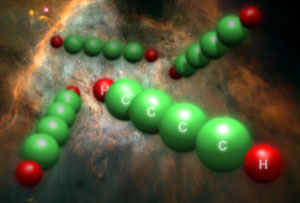Scientists have managed to find within interstellar clouds with extremely low density a fragment with a complex, surprising and unexpected structure. The discovery will require a change in our thinking regarding chemical processes that occur in regions of the galaxy that seem to be empty.

Scientists have managed to find within interstellar clouds with extremely low density a fragment with a complex, surprising and unexpected structure. The discovery will require a change in our thinking regarding chemical processes that occur in regions of the galaxy that seem to be empty.
Semi-transparent interstellar clouds are permeable to high-energy ultraviolet and cosmic rays capable of breaking down any chemical substance in their path. However, a group of scientists, mainly composed of Polish astrophysicists and astrochemists, managed to identify in these clouds a substance composed of an unexpectedly high number of atoms: the di-acetylene cation. The discoveries of this proto in very low-density gas and dust clouds could contribute to the solution of an age-old spectroscopy puzzle.
The density present in semi-transparent interstellar clouds is extremely low. "The sparseness of matter in these clouds is similar to the density obtained as a result of dispersing air in the volume of one glass over the area of a small country. This value is much lower than the best vacuum that can be produced in the laboratory today," explains one of the research partners, Professor Robert Kołos from the Institute of Physical Chemistry at the Polish Academy of Sciences. However, since the interstellar clouds are enormous in size, and it takes tens of light years to reach them, the gas plumes in them have a reasonable chance of reacting with the radiation penetrating through the clouds. Spectroscopy is the field of scientific research that examines the interrelationship between matter and radiation.
Particles absorb and emit photons with only a specified amount of energy (and therefore with specified wavelengths) that corresponds to the gap between the typical energy levels in the particular form. As a result, as a result of the interactions with the thin gases found in the interstellar clouds, which are common in our galaxy and in other galaxies, the stellar radiation that reaches the Earth undergoes slight changes and is missing certain wavelengths - those absorbed by atoms and particles found in outer space.
In the twenties of the last century, astrophysicists noticed that the radiation was absorbed by the interstellar medium in a way that could not be explained by the presence of very simple components of interstellar gas, which were known at the time. Today, thanks to the use of radio waves, it is possible to identify relatively large atoms - the current record is for the atom cyanopolyyne (HC11N) consisting of thirteen atoms - but these were formed inside dense and opaque clouds protected from disintegrating radiation.
"The strange optical properties of semi-transparent clouds, together with the presence of so-called Diffuse Interstellar Bands (DIB), have been a mystery for ninety years. They have even been called the longest unsolved problem in all of spectroscopy,” says Professor Krełowski, a leading researcher in the field of optical spectroscopy of the interstellar medium. The latest discovery made it possible to add a new absorption to the collection of DIB absorptions, and at the same time it was deciphered that it originates from the diacetylene cation H-CC-CC-H+. "Di-acetylene is a pollutant expected to be too large to be present in semi-transparent clouds. To date, particles have been found in these clouds that contained no more than three atoms only: the carbon atom C3 and the hydrogen atom H3+. In order to properly explain the presence of the diacetylene cation, we will have to correct the existing astrochemical theories," adds the researcher.
Asymmetric fibers - such as the cyanopolyene fiber mentioned above, which has a linear sequence of carbon atoms containing a hydrogen atom at one end and a nitrogen atom at the other end - are capable of receiving/emitting electromagnetic waves in the radio frequency range. The high structural symmetry of the diacetylene cation makes it invisible to radio telescopes, but updated optical observations suggest that this cation is a fairly common component of the interstellar medium. It was discovered not only in the two regions of the galaxy rich in carbon atoms, but also in processed data from dozens of other regions.
Following the discovery of the diacetylene cation, it can be assumed that there are other sparse radiation absorptions that originate from similar symmetrical separations. "It is likely that the DIB mystery will be solved soon, for the most part," Professor Krełowski concludes.

5 תגובות
Zoron in Hebrew is translated in Wikipedia (in Hebrew..) to "Polymorph", that is
One of many possible forms for the same thing (polymorphism):
A carbon crystal can for example be in the form of a diamond or in the form of graphite, the same
The term polymorphism also exists in engineering, genetics and even computer programming.
Hello Les. pecan:
The foreign term "chemical species" is translated into Hebrew as: "chemical species" according to the Academy of the Hebrew Language, a dictionary of the type - Chemistry: Chemical Engineering (1989)
sorry but:
What is "Tsuron"? The interpretation does not appear in any online dictionary.
It is also requested that, when using technical terms translated into Hebrew, to attach - even once - the original as well.
Thanks
God planned them
It is not so surprising that this molecule exists in space -
First, it is not written in what doses the molecule exists (relative to other molecules), and I assume that it is low.
Second, hydrogen is the dominant atom in space by nature, and carbon is known for its chemical composition properties, mainly spontaneous and organic.
These atoms came (at some point) from some place that is not a vacuum, and sailed into space.
They may form in some kind of star or explosion, and be traceable.
with fun 3.